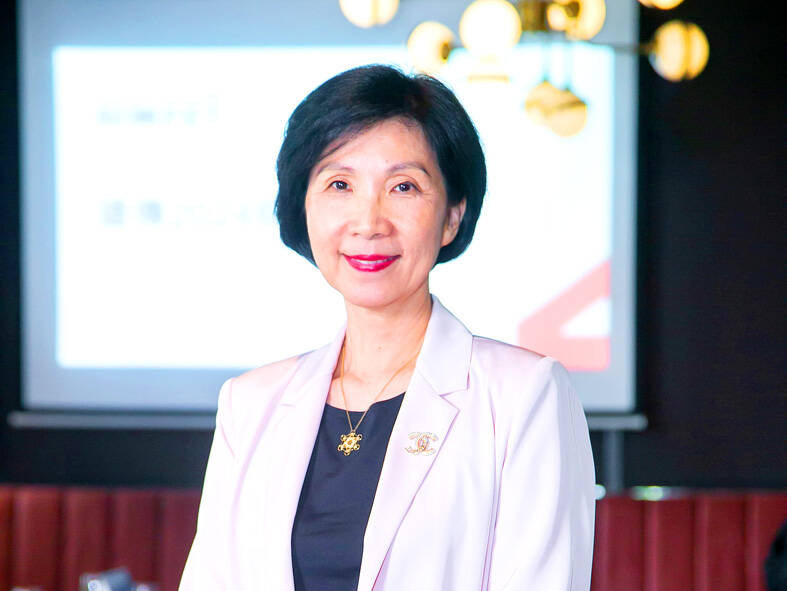Far EasTone Telecommunications Co (遠傳電信) yesterday said it aims to turn around its earnings next year and hopes to report healthy double-digit percentage growth in 2026, aided by its acquisition of Asia Pacific Telecom Co (亞太電信).
The telecom’s earnings per share fell 4.1 percent to NT$0.81 in the first three months of this year, compared with NT$0.85 in the same period last year, diluted by an increase of 9.6 percent in capital shares.
However, net profit increased 6.1 percent year-on-year to NT$2.92 billion (US$90.18 million) from NT$2.75 billion, surpassing the company’s forecast of NT$2.8 billion per quarter.

Photo courtesy of Far EasTone Telecommunications Co via CNA
“We hope to make a turnaround in the second year [of the Asia Pacific Telecom acquisition]. For the third year, we hope to return to our previous growth path of double-digit percentage growth,” Far EasTone president Chee Ching (井琪) told reporters in Taipei. “Earnings in 2026 will exceed that of last year.”
Far EasTone formally acquired Asia Pacific Telecom on Dec. 15 last year. The acquisition helped boost Far EasTone’s mobile subscriber base to 9.08 million users at the end of last year from 7.22 million in the third quarter of last year.
However, the acquisition was a drag on its average revenue per unit (ARPU) in the initial phase.
Far EasTone’s ARPU fell to NT$695 last quarter, from NT$746 in the fourth quarter of last year, as a bulk of Asia Pacific Telecom’s users are low-tariff subscribers.
“We expect to see significant incremental growth in ARPU,” Ching said, citing the company’s three-year business plan implemented following the absorption of the smaller telecom.
“We will offer more value-added services, including new artificial intelligence applications, to drive ARPU. We already have some on offer and will have much more this year and next year in collaboration with start-up partners,” she said.
Far EasTone has already shown some positive signs of growth, as about 70 percent of Asia Pacific Telecom users signed up for higher-tariff subscriptions when they switched to Far EasTone, the company said.
Far EasTone expects its 5G penetration to climb to about 45 percent this year, compared with 37 percent at the end of last year together with Asia Pacific Telecom.
Far EasTone said it expects 20 percent of its total revenue to come from non-traditional telecom services, a similar portion to last year.
Revenue this year is expected to increase 12 percent annually from NT$93.69 billion last year, it said.
The telecom said the acquisition would help save operational expenses from the second half of this year, following the integration of its base stations with those of Asia Pacific Telecom.
Capital expenditure would fall to NT$7.3 billion this year from NT$8.1 billion last year, it added.

Taiwan Semiconductor Manufacturing Co (TSMC, 台積電) last week recorded an increase in the number of shareholders to the highest in almost eight months, despite its share price falling 3.38 percent from the previous week, Taiwan Stock Exchange data released on Saturday showed. As of Friday, TSMC had 1.88 million shareholders, the most since the week of April 25 and an increase of 31,870 from the previous week, the data showed. The number of shareholders jumped despite a drop of NT$50 (US$1.59), or 3.38 percent, in TSMC’s share price from a week earlier to NT$1,430, as investors took profits from their earlier gains

In a high-security Shenzhen laboratory, Chinese scientists have built what Washington has spent years trying to prevent: a prototype of a machine capable of producing the cutting-edge semiconductor chips that power artificial intelligence (AI), smartphones and weapons central to Western military dominance, Reuters has learned. Completed early this year and undergoing testing, the prototype fills nearly an entire factory floor. It was built by a team of former engineers from Dutch semiconductor giant ASML who reverse-engineered the company’s extreme ultraviolet lithography (EUV) machines, according to two people with knowledge of the project. EUV machines sit at the heart of a technological Cold

AI TALENT: No financial details were released about the deal, in which top Groq executives, including its CEO, would join Nvidia to help advance the technology Nvidia Corp has agreed to a licensing deal with artificial intelligence (AI) start-up Groq, furthering its investments in companies connected to the AI boom and gaining the right to add a new type of technology to its products. The world’s largest publicly traded company has paid for the right to use Groq’s technology and is to integrate its chip design into future products. Some of the start-up’s executives are leaving to join Nvidia to help with that effort, the companies said. Groq would continue as an independent company with a new chief executive, it said on Wednesday in a post on its Web

CHINA RIVAL: The chips are positioned to compete with Nvidia’s Hopper and Blackwell products and would enable clusters connecting more than 100,000 chips Moore Threads Technology Co (摩爾線程) introduced a new generation of chips aimed at reducing artificial intelligence (AI) developers’ dependence on Nvidia Corp’s hardware, just weeks after pulling off one of the most successful Chinese initial public offerings (IPOs) in years. “These products will significantly enhance world-class computing speed and capabilities that all developers aspire to,” Moore Threads CEO Zhang Jianzhong (張建中), a former Nvidia executive, said on Saturday at a company event in Beijing. “We hope they can meet the needs of more developers in China so that you no longer need to wait for advanced foreign products.” Chinese chipmakers are in